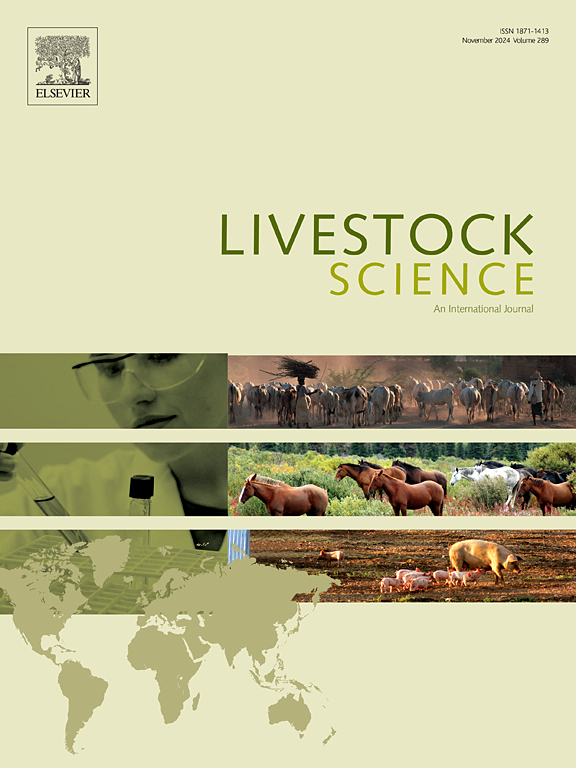Development of updated maintenance energy requirements of cattle using calorimeter data of growing cattle and suckler cows
IF 1.9
3区 农林科学
Q2 AGRICULTURE, DAIRY & ANIMAL SCIENCE
引用次数: 0
Abstract
An accurate prediction of maintenance energy requirement is essential for rationing growing cattle and suckler cows for improved production efficiency and reduced environmental footprint. There is evidence that the current UK energy feeding system (Agricultural and Food Research Council,1993) underpredicts maintenance energy requirement for growth of modern cattle. The objective of the present study was to develop updated maintenance energy requirements for growing cattle. Data used were collated from calorimeter chamber studies (each with digestibility measurements) undertaken at the Agri-Food Biosciences Institute (n = 249) and the University of Reading (n = 48) between 1993 and 2015. The dataset comprises data from 176 growing dairy and beef steers, 88 growing Holstein-Friesian heifers and 34 dry mature suckler cows. Cattle were offered diets containing either forage only (n = 81) or a mixture of forage and concentrates (n = 211) at various feeding levels. Energy intake and outputs were measured using indirect open-circuit respiration calorimeter chambers and digestibility trials. Linear and multiple linear regressions between retained energy (RE) and ME intake (MEI) were used to determine the net energy (NEm) and metabolisable energy (MEm) requirements for maintenance of body tissue energy without loss or gain. Data were analysed using a linear mixed model (restricted maximum likelihood estimation method), with animal gender, live weight, forage type and dietary forage proportion fitted as additional fixed effects while research centre, experiment and chamber number as random effects. The NEm derived from the linear relationship between RE and MEI was 0.42 MJ/kg0.75 of live weight (equivalent to 0.40 MJ/kg0.75 of calculated empty body weight). The MEm values were determined to be 0.53 and 0.55 MJ/kg0.75 of live weight (equivalent to 0.50 and 0.52 MJ/kg0.75 of calculated empty body weight) using multiple linear regressions of MEI against metabolic live weight and positive and negative RE. The present NEm or MEm values are 24 % or 13 % and 17 % higher than those recommended by AFRC (1993). The present result indicates that use of AFRC (1993) to ration modern growing cattle underestimates their maintenance energy requirements.
利用生长牛和乳牛的量热计数据开发更新的牛维持能量需求
准确预测维持能量需求对于配给生长牛和乳牛以提高生产效率和减少环境足迹至关重要。有证据表明,目前的英国能量喂养系统(农业和食品研究委员会,1993年)低估了现代牛生长的维持能量需求。本研究的目的是为生长牛制定最新的维持能量需求。所使用的数据整理自1993年至2015年间在农业食品生物科学研究所(n = 249)和雷丁大学(n = 48)进行的热量计室研究(每个研究都有消化率测量)。该数据集包括176头生长中的奶牛和肉牛,88头生长中的荷斯坦-弗里西亚小母牛和34头干成熟乳牛的数据。在不同的饲喂水平上,分别给牛饲喂饲料(n = 81)或饲料和精料的混合物(n = 211)。使用间接开路呼吸量热计室和消化率试验测量能量摄入和输出。利用保留能(RE)和代谢能摄入量(MEI)之间的线性和多元线性回归来确定维持身体组织能量而不损失或增加的净能(NEm)和代谢能(MEm)需求。采用线性混合模型(限制最大似然估计法)对数据进行分析,拟合动物性别、活重、饲料类型和饲粮饲料比例为附加固定效应,拟合研究中心、试验和试验室数为随机效应。由RE和MEI的线性关系得到的NEm为活重0.42 MJ/kg0.75(相当于计算空体重0.40 MJ/kg0.75)。利用MEI对代谢活重和阳性和阴性RE的多元线性回归,确定了MEm值为活重0.53和0.55 MJ/kg0.75(相当于计算空体重0.50和0.52 MJ/kg0.75)。目前的NEm或MEm值比AFRC(1993)推荐值高24%或13%和17%。目前的结果表明,使用AFRC(1993)定量配给现代生长牛低估了它们的维持能量需求。
本文章由计算机程序翻译,如有差异,请以英文原文为准。
求助全文
约1分钟内获得全文
求助全文
来源期刊

Livestock Science
农林科学-奶制品与动物科学
CiteScore
4.30
自引率
5.60%
发文量
237
审稿时长
3 months
期刊介绍:
Livestock Science promotes the sound development of the livestock sector by publishing original, peer-reviewed research and review articles covering all aspects of this broad field. The journal welcomes submissions on the avant-garde areas of animal genetics, breeding, growth, reproduction, nutrition, physiology, and behaviour in addition to genetic resources, welfare, ethics, health, management and production systems. The high-quality content of this journal reflects the truly international nature of this broad area of research.
 求助内容:
求助内容: 应助结果提醒方式:
应助结果提醒方式:


